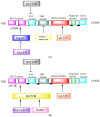Targeting mTOR as a Cancer Therapy: Recent Advances in Natural Bioactive Compounds and Immunotherapy
- PMID: 36428613
- PMCID: PMC9688668
- DOI: 10.3390/cancers14225520
Targeting mTOR as a Cancer Therapy: Recent Advances in Natural Bioactive Compounds and Immunotherapy
Abstract
The mammalian target of rapamycin (mTOR) is a highly conserved serine/threonine-protein kinase, which regulates many biological processes related to metabolism, cancer, immune function, and aging. It is an essential protein kinase that belongs to the phosphoinositide-3-kinase (PI3K) family and has two known signaling complexes, mTOR complex 1 (mTORC1) and mTOR complex 2 (mTORC2). Even though mTOR signaling plays a critical role in promoting mitochondria-related protein synthesis, suppressing the catabolic process of autophagy, contributing to lipid metabolism, engaging in ribosome formation, and acting as a critical regulator of mRNA translation, it remains one of the significant signaling systems involved in the tumor process, particularly in apoptosis, cell cycle, and cancer cell proliferation. Therefore, the mTOR signaling system could be suggested as a cancer biomarker, and its targeting is important in anti-tumor therapy research. Indeed, its dysregulation is involved in different types of cancers such as colon, neck, cervical, head, lung, breast, reproductive, and bone cancers, as well as nasopharyngeal carcinoma. Moreover, recent investigations showed that targeting mTOR could be considered as cancer therapy. Accordingly, this review presents an overview of recent developments associated with the mTOR signaling pathway and its molecular involvement in various human cancer types. It also summarizes the research progress of different mTOR inhibitors, including natural and synthetised compounds and their main mechanisms, as well as the rational combinations with immunotherapies.
Keywords: cancer; immunotherapy; mTOR; mTOR inhibitors; natural drugs.
Conflict of interest statement
The authors declare no conflict of interest.
Figures


References
Publication types
LinkOut - more resources
Full Text Sources
Miscellaneous

